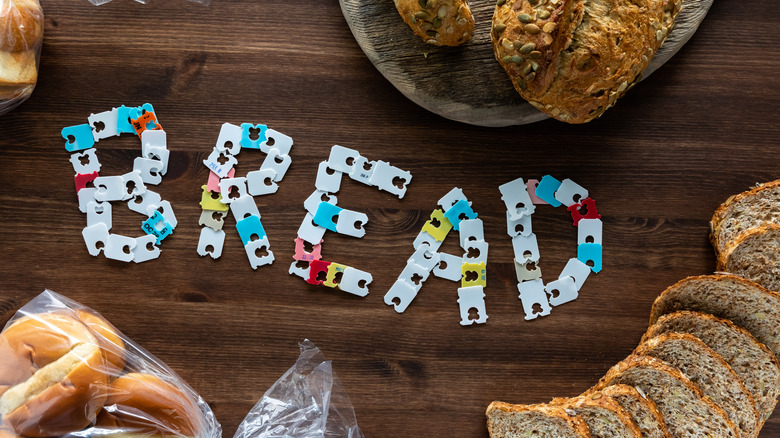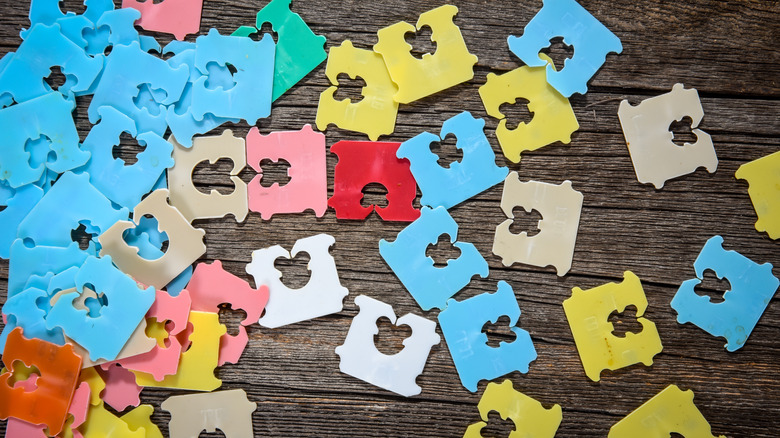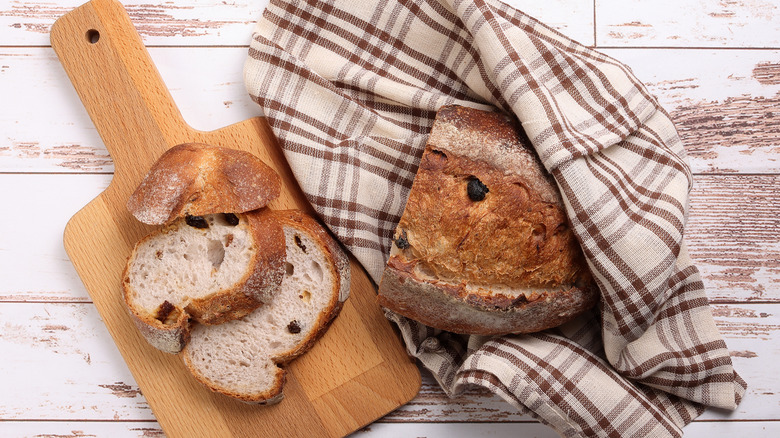Those Color-Coded Plastic Bread Tags Are Cluing You In About Freshness
When it's lunchtime, and you only have time for something quick to fill the hole in your stomach, a simple loaf of bread can save the day. You can go big by heaving a generous helping of roast beef and cheddar on the bread if you're feeling particularly ravenous, or you can make a light tomato and mayo sandwich to get you through the afternoon. Of course, you want the freshest bread for that lunchtime snack, but it often seems like there is no way to tell which loaf is the freshest when you're in the store.
The easiest way to determine when those loaves of bread hit the shelves has been staring you in the face this whole time. Bread is usually closed with a plastic bread tag, sometimes referred to as a bread clip or buckle. This tag is a specific solid color, and that color signifies when the bread was baked. If the bread tag is blue, the bread was put out on Monday, whereas bread made on Tuesday will have a green tag attached to the bag. Thursday and Friday are labeled with red and white tags respectfully, and bread made on Saturday has a yellow tag. Bakeries typically take a break from production on Wednesdays and Sundays, so no colors are associated with those days.
Remembering the color system
But in this modern age, where we can't even be bothered to hold a phone number in our heads, are we really expecting you to memorize this? Of course not! All you need to remember is that the color order tracks with the alphabet. So to recap: (B)lue for Monday, (G)reen for Tuesday, (R)ed for Thursday, (W)hite for Friday, and (Y)ellow for Saturday.
Bread items are stocked quite frequently, so it's not out of line to think you can get something the day of, or at least the day before. So at the beginning of the work week, you want to avoid anything made the prior week (on the tail end of the alphabet), and at the end of the week, avoid the Bs, Gs, and maybe the Rs.
It's worth noting that this color-coding technique is primarily used with bread made in-store or bought from a cooperating bakery. Individual big-name distributors may not use this exact method (or even the buckle), but those colored twist ties likely also have a pattern that's worth sussing out if you're loyal to it. This is a tip for snagging the freshest loaves one can, and, while you should always give the "Best By" date a glance, relative freshness can generally be expected as bread shelves are one of the most visited in any market.
How to keep bread fresh
Still, the shelf life is finite; bread will usually stay fresh for 3 to 7 days, depending on the type of bread you pick up and how it's stored. One way to keep bread at its freshest is to remove the plastic bag the bread likely came in and instead wrap it in linen or a cotton cloth. This is because a plastic bag can trap moisture, which can lead to mold growth; wrapping it in linen keeps it covered but allows the bread to get a good amount of airflow.
The ingredients in the bread will also factor into how long your loaf stays fresh. Breads like sourdough contain lactic acid bacteria, which prevent bread from going stale and prevent mold growth, so they tend to have a longer shelf life than a simple loaf of white bread. Gluten-free bread, on the other hand, contains more moisture than other breads and doesn't contain many preservatives, which makes it highly susceptible to mold growth. Most gluten-free bread is stored frozen for this reason.
No matter what kind of bread you decide is right for your middle-of-the-day meal, knowing the color-code system used for tracking bread production dates will help you walk out of the store with the freshest possible loaf.


